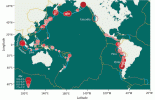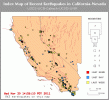http://www.veteranstoday.com/2011/03/28/from-hiroshima-to-fukushima-1945-2011/ said:
……………………………
The tight juxtaposition of many installations for generating nuclear power, processing nuclear waste, and storing nuclear waste within the narrow confines of the one-and-a half square mile site of the maimed Fukushima plant epitomizes the irresponsibility of a troubled industry. The depth of the problem is confirmed by the failure of nuclear regulators to explain clearly in the course of the current crisis the immensity of problems generated by the need to isolate vast quantities of toxic nuclear material from any exposure whatsoever to air, to water, and to all living organisms over hundreds of thousands of years. In speculating that the Fukushima disaster could fast be approaching its “Chernobyl Moment,” Mike Whitney has cautioned that much of the mainstream media’s goal has been “to conceal the scale of the catastrophe in order to protect the nuclear industry.”
……………………………
The deliberate combination of the most antique nuclear reactors with the most advanced form of high-octane nuclear fuel is so wildly negligent that it is almost certainly constitutes a criminal violation of public safety laws. There were many interventions in Japanese courts seeking to block this nuclear madness. Unfortunately the interventions to protect public health failed.
Much of the controversy revolves around the activities of a so-called nuclear reprocessing site at Rokkasho. Starting in October of 2010, AREVA’s plutonium-laced rods began to be loaded into the nuclear fuel tank of Reactor 3. Reactor 3 is the core installation surrounded by containment shed that on March 14 exploded high into the air in full view of nearby cameras. This explosion occurred two days after the initial blast at Reactor #1, also clearly captured on camera. AREVA’s first corporate response to the disaster was, like GE, to disclaim any legal liability for its role in the disaster. AREVA’s spin doctors then quoted approvingly a newspaper editorial asserting, “The public needs to calm down, the environmentalists need to quit trying to make political hay out of a grave crisis, and the politicians need to grow a spine.”
……………………………………..
One of the primary motivations for building nuclear power plants in the first place has been to produce the plutonium needed for the construction of nuclear weapons. This overlapping of functions continues yet. The tight integration of the business of designing and manufacturing nuclear devices as weapons of mass destruction and the business of using nuclear fuel to generate electricity for broad public consumption needs to be emphasized again and again. To gain insights into the linkages between the building of nuclear power plants and the construction of nuclear weapons one need only consider the controversy attending relevant developments in Israel, India, Pakistan and North Korea. In 1945 at the dawning of the nuclear age none of these countries even existed except for India. At the time India was still a colony of Great Britain. The controversy currently swirling around Iran’s nuclear program repeats in a new context the controversy surrounding earlier stages of the efforts to prevent the proliferation of nuclear weapons.
The persistently persecuted whistle blower, Mordechai Vanuna, provided the world in 1986 with pictures illustrating the thick web of industrial connections linking the generation of nuclear energy and the development of nuclear weapons in Israel. His photographs shed considerable light on Israel’s top-secret installations for the manufacturing of nuclear devices at the Dimona complex in the southeastern corner of one of the world’s most heavily militarized countries. Another illustration of this same pattern came to light when it was reported in 2010 that the weapons-grade tritium manufactured at the Tennessee Valley Authority’s Sequoyah Nuclear Power Plant would be channeled to the production of nuclear weapons in the United States.
…………………………………………………………
The approval of this transfer by President Barack Obama should not come as a surprise. He and many members of his inner circle, including David Axelrod and Rahm Emanuel, have received significant financial and political backing from the Exelon Corporation, the biggest operator of nuclear power plants in the United States. Exelon runs 10 nuclear power stations with a total of 17 reactors. The core of their nuclear empire is in Illinois, the home state of the current US president. One of Barack Obama’s major fund raisers is John Rogers Jr., a member of the Exelon board and Chairman of Ariel Investments.
From its inception in the darkest days of the Cold War, the nuclear energy industry was designed with a view to providing a more civilized civilian face to the stealthy operations of a military establishment that developed atomic energy as medium for mass destruction, including mass murder, on an unprecedented scale. Some telling continuities have been placed on full display, therefore, in the linkages connecting the subjugation of the Japanese to the horrors of state terror at Hiroshima and Nagasaki and to the present prospect of their slow submission to nuclear-induced sicknesses and deformities from the failed experiment in nuclear deregulation at Fukushima. The prospect of this nuclear plague spreading to surrounding countries and regions helps to underline the obsolescence of our outmoded conceptions of national sovereignty in the twenty-first century.
………………………………
If and when the investigations take place into the genesis of the nuclear disaster presently underway in Japan, it will be important to look much higher up the chain of responsibility and command than the officials of the Tokyo Power Company. The notorious corruption and fraud of TEPCO officials is but a low-level manifestation of an interlocked system of global power based on the tight marriage of banking, military and media empires. In the closed kleptocracy of this increasingly concentrated and unaccountable complex of governance by the few, of the few and for the few, conflict-of-interest, bribery, blackmail, negligence, cover-up and failures of due diligence are given wide latitude. Under these circumstances the supposed safeguards thought to reside in periodic elections, even in the so-called liberal democracies, have become little more than window dressing in a political culture modeled to replicate the appearance of choice between, say, Pepsi and Coke, Westinghouse and General Electric, Hitachi and Toshiba.
…………………………………….
The nature of humanity’s shared dilemma is highlighted by the propensity of our mass media of disinformation to point our attention away from those most responsible for the creating the conditions behind the Fukushima crisis—behind the massive breakdown of technology, ecology, public health, and political economy embodied by this disaster. What happened in the background of this debacle that thrust the employees of TEPCO, a private, for-profit company, into the untenable position assigned them after March 11? What led up to the crisis still unfolding after a predictable tsunami swept over the nuclear waste dumps and the live museum of antiquated nuclear devices assembled in the Fukushima #1 just a hundred and fifty miles north of Tokyo? How could this combination of nuclear dangers been allowed to develop in Japan, one of the most active island earthquake zones on earth?
……………………..
Admiral Rickover was chosen by the US Navy with the objective of integrating the naval division of the US Armed Forces more deeply into the profound realignment of many kinds of power that came about with the introduction of atomic weapons. Very early on Rickover seized on the objective of extending the utilization of nuclear energy not only to the propulsion of naval vessels but also to the large-scale generation of electricity for more general consumption. He was encouraged to move in this direction by a number of allies in the so-called private sector, executives in companies like GE, Westinghouse and General Dynamics. These firms, like the majority of large manufacturing enterprises based in the United States, had expanded exponentially while acting as military partners of the US government during the Second World War. Rickover played a major role in working with his staff to set up the legal structure of the nuclear energy industry in ways that advanced the proprietary interests of the corporate partners that have long been deeply integrated into the core operations of the US Armed Forces.
……………………………
Eisenhower’s “Atoms for Peace” speech was seized upon by the United States’ Cold Warriors as a major theme of US foreign policy. It provided a blueprint for one aspect of a more overarching US project to integrate US allies or potential US allies into the industrial cycles of US-based corporations and the financial cycles of debt and credit as administered by US-based banking regimes. It provided a blueprint to advance an agenda of Cold War capitalism geared to the special interests of US military hegemony as linked to the special interests of large US businesses and their expanding international networks of consumers, suppliers, partnerships, franchises, technological transfers, and patent arrangements.
As proclaimed in 1955 by the National Security Council, one of the core expressions of the enormous expansion of the US Executive Branch as the primary global agency charged with the formal, informal and covert attacks on communism, “Atoms for Peace will strengthen American world leadership and disprove the Communists’ propaganda charges that the US is concerned solely with the destructive uses of the atom.” A Congressional Committee on Nuclear Energy came up with a similar recommendation in 1956 arguing, “Atomic power must be the most tangible symbol of America’s will to peace through the peaceful atom.”
…………………………..
The establishment of the nuclear power industry in Japan emerged from the same set of forces that were integral to the establishment and deployment of the Japanese television industry as a medium of American-led anti-communism. This convergence of factors, all taking their queues from the psychological warfare of the Cold War, has run through the history of the US-based and Japan-based megacorporations that have had a hand in designing, manufacturing and installing the industrial infrastructure of Fukushima Nuclear Plant Number One. Figuring prominently among these corporate entities are General Electric and Westinghouse as well as some of Japan’s Zaibatsu-based conglomerates, but especially Hitachi, Toshiba and Mitsubishi.
………………………………….
The Zaibatsu-based partners of the American conglomerates epitomize strands of continuity linking the pre and post-WWII political economy of Japan. It was the imperatives of anti-communism that drove the US decision to revive the old Zaibatsu-based structures of productivity and authority that had animated the war machine whose imperial masters had ordered the attack on Pearl Harbor in 1941. Knowledge of this history is crucial to the success of any effort to understand the genesis of the political decisions resulting in the placement of the world’s third-largest nuclear energy industry on one earth’s most earthquake-prone zones.
…………………………………….
As Richard Falk has observed in his reflections on the Faustian bargains of the nuclear age, the risks of nuclear energy “if objectively assessed, were widely known for years, yet effectively put to one side.” He continues, “It is the greedy profit-seekers who minimize and suppress these risks, whether in the Gulf of Mexico or Fukushima or on Wall Street, and then scurry madly at the time of disaster to shift responsibility to the victims that makes me tremble as I contemplate the human future.”xlv Falk’s observation about the shifting of responsibility to the victims in times of disaster is tellingly born out by a report in Bloomberg News. On March 23 the news agency reported, “Japan’s taxpayer, not the nuclear industry, will cover most of the cleanup cost from the worst accident since Chernobyl, a financial rescue that may spur moves by other nations to make companies assume more liability.”
It is the employees and officers of the Toyko Power Company, TEPCO, who seemingly still remain the main crisis team to deal with the Fukushima disaster and to interpret its character and scope for the public. According to a report in Bloomberg News, the corporate entity that appears presently to be bearing the bulk of the responsibility is not financially responsible for the full extent of the damages that will be incurred because of what is transpiring at its nuclear plant. TEPCO is apparently liable for the third-party damages resulting from the incident only up to the amount of $2.1 billion. Unfortunately this figure seems small compared to the scope of the disaster that continues to unfold. Bloomberg added, “Should the government declare the magnitude-9 earthquake and tsunami that flooded its reactors an ‘exceptional’ act of God, the utility may be off the hook in paying compensation that may be demanded by injured workers, farmers and shareholders.”
While TEPCO apparently has already established its limited corporate liability, the first concern of ARVEDA and GE and many other companies involved in the man-made elements of the disaster has been to defend their products and thereby attempt to avert the prospect of being sued for various forms of malfeasance. On March 18, for instance, GE issued a press release indicating, “The Mark I meets all regulatory requirements and has performed well for over 40 years.” GE added, “The Mark I containment designs were modified in the 1980s to address improvements in the technology and changing regulatory requirements. All these changes required by regulatory authorities have been implemented.”
This pattern of companies seeking to escape legal liabilities for their inventions and production procedures in manufacturing and operating nuclear devices has been clear and consistent from the start of the industry. In commenting on the requirements of Charles Wilson, the CEO of General Electric during the Second World War, an historian of the project to construct the first atomic weapons observed, “GE expected full recovery of all costs incurred in connection with the contract and protection against liabilities, since hazards of ‘an unusual and unpredictable nature’ were involved.” There were to be no exceptions in the seminal phase of the nuclear industry to the uniform “insistence” of corporations that they must be “completely free of liability for their actions.”
The indemnification of private companies from the consequences of accidents in the nuclear energy industry was formalized with the Price-Anderson Act of 1957. It amended parts of the Atomic Energy Act of 1946 that established the Atomic Energy Commission. One reason given for making taxpayers the ultimate backstop for potential payouts to those killed or injured by the activities of the corporate agencies of the nuclear energy industry was that no private insurance companies were willing to assume the risks in this line of enterprise. Congress renewed the Price-Anderson Act in 1967, 1975, 1988, and 2005. Its most recent extension in 2005 was legislated to run for twenty additional years.
The Price Andersen Act provided a legal prototype that was basically exported along with American nuclear technology to those countries that accepted US leadership in this field. The legacy of the way the American “Atoms for Peace” initiative was absorbed into the industrialization of Japan after WWII helps explain why those masses of citizens attempting to cope with the aftermath of the worst natural disaster in their history are left holding the bulk of the liability for a preventable, or at least partially preventable, nuclear accident whose full horrible extent remains unclear.
…………………………….
Like the financial meltdown and BP’s industrial toxification of the Gulf of Mexico, the Fukushima nuclear disaster seems like yet another dramatic example of an increasingly familiar pattern. The nuclear crisis in Japan illustrates yet again what happens when the delivery of public services, including the provision of public utilities, are passed to the so-called private sector. It illustrates what happens when these and other key businesses are left unregulated and when the public is left to bear the consequences and pay the costs of enormous corporate transgressions. Again and again, it seems, profits are privatized whereas the attending costs of doing business in terms of deteriorating public health, citizens’ savings, social cohesion, and ecological equilibrium are simply swallowed or socialized as the debt of taxpayers to be carried over long periods of time. “Let posterity pay” seems to have become the motto of our unstable and unsustainable system of economic relationships.

 That is horrific/intense information!
That is horrific/intense information! 



